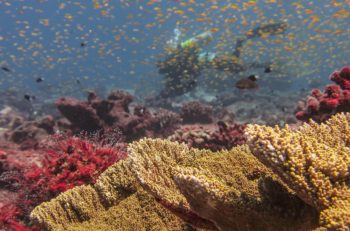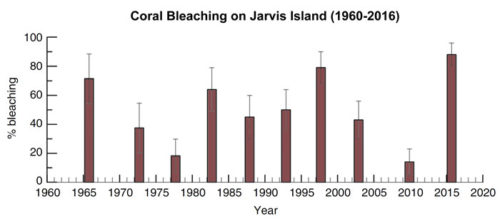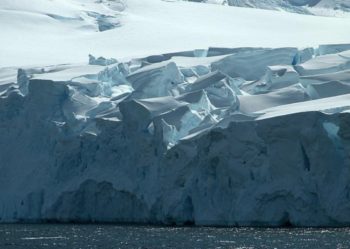
Consequently, many are concerned about the ability of corals to survive even a modest temperature rise, with many persons predicting these key marine lifeforms will suffer widespread decline and possible extinction in the future.
However, this fate is far from certain; several studies have observed that many corals possess a high degree of resilience to temperature-related stresses, experiencing relatively quick recoveries when the stresses depart.
Support for this latter thesis is noted in reviews of several studies archived in our Subject Index under the heading Coral Reefs (Responses to Temperature Stress: Recovery and Resilience).
And now, the work of Barkley et al. (2018)* can be added to this growing body of literature.
As their contribution to the topic, the team of fifteen researchers utilized skeletal signatures preserved in long-lived Porites corals found on the reef surrounding Jarvis Island in the central Pacific Ocean to reconstruct a near six-decade-long history of coral bleaching caused by extreme El Niño warming events.
Jarvis Island is within the U.S. Pacific Remote Islands Marine National Monument (0.37°S, 159.99°W) and represents an uninhabited coral reef ecosystem that according to Barkley et al. “was ranked one of the healthiest ecosystems in the global ocean in 2012.”
Based on analyses of the Porites corals, the authors report Jarvis Island has had a long history of both moderate (less than 30%) and severe (greater than 30%) bleaching events, including the ten events depicted in Figure 1 below.

With respect to this history, Barkley et al. note that “the record implies that the Jarvis coral community has bleached with varying degrees of severity every five years, on average.”
And yet despite such periodicity, they say they did “not detect a statistically significant increase in the severity of bleaching over time nor an increase in the frequency of bleaching events in the last 60 years.”
In contemplating the above findings, Barkley et al. say that their historical bleaching reconstruction “reveals a coral reef community that has bleached frequently, and at times catastrophically, yet appears to have maintained a healthy state over time.”
This fact is incredibly important and speaks to the resilience of this community given that it was ranked among the healthiest of all ocean ecosystems, notwithstanding it has experienced repeated episodes of moderate to severe bleaching every five years.
It is also important to point out another small, yet key, observation in this study. According to the authors, recurring bleaching events were also identified prior to the six decades of time focused on in their study (1960-2016).
As noted, Barkley et al. report that “two [Porites] cores extend back to the turn of the 20th century, and the earliest stress bands appear in these cores in 1912, indicating that bleaching occurred on Jarvis over 100 years ago” (emphasis added).
So what does all the above suggest? It suggests an incredible resilience for a coral reef community that has repeatedly experienced dramatic fluctuations in ocean temperature and biogeochemical change.
And, it suggests rising atmospheric CO2 and rising ocean temperatures over the course of the past century have had no measurable impact on either the frequency or severity of El Niño warming events.
*Paper Reviewed
Barkley, H.C., Cohen, A.L., Mollica, N.R., Brainard, R.E., Rivera, H.E., DeCarlo, T.M., Lohmann, G.P., Drenkard, E.J., Alpert, A.E., Young, C.W., Vargas-Ángel, B., Lino, K.C., Oliver, T.A., Pietro, K.R. and Luu, V.H. 2018. Repeat bleaching of a central Pacific coral reef over the past six decades (1960-2016). Communications Biology 1: 177, DOI: 10.1038/s42003-018-0183-7.
Read more at CO2 Science
















